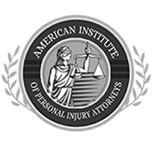
After suffering from a truck accident injury, moving forward can be difficult, especially if you’re not sure how you’ll pay your next medical bill or what your legal rights are in this situation. The consequences can be utterly tragic when an 18-wheeler is involved in an accident.
This accident involving a passenger vehicle, three tractor-trailers, and a bus resulted in 60 people being injured and five killed.
The video is frightening to watch, but you need to know just how devastating a truck accident can be.
Understanding truck accident statistics is crucial in order to identify risks, implement safety measures, and promote accident prevention. While every truck accident is different, we believe it’s important for you to know just how widespread they are and who to contact to protect your rights.
At Patrick Daniel Law, we want you to know you’re not alone. If you’ve suffered a truck accident injury or if a loved one has lost their life, call (713) 999-6666 to schedule a FREE case review with our experienced truck accident lawyer.
According to the Insurance Institute for Highway Safety (IIHS), “Most deaths in large truck crashes are passenger vehicle occupants.” Passenger cars weigh 20–30 times less than large trucks and are much smaller. An 18-wheeler’s high ground clearance can result in passenger vehicles sliding under the hulking vehicles. This type of accident, called underriding, is incredibly destructive, leading to severe injuries and fatalities.
In 2021:
According to the IIHS, 31% of passenger vehicle occupants who died in two-vehicle crashes with a large truck in 2021 were struck head-on by the truck, and 24% were side-struck by the truck. 23% of truck accidents involved the front of the passenger vehicle striking the rear of the truck.
Roadway departure crashes, where vehicles veer off the road, can result in severe truck accident injuries. Factors contributing to roadway departure crashes include driver fatigue, distraction, impaired driving, and inadequate road design.
Truck accidents often occur at intersections or in rear-end collisions. Factors contributing to intersection accidents include inadequate visibility, failure to yield the right of way, and red light violations.
Trucks are involved in a significant number of work zone accidents. The FMCSA reported that in 2019, 33% of fatal work zone crashes involved at least one large truck. Adhering to work zone speed limits, maintaining a safe following distance, and heightened awareness are crucial for truck drivers to prevent work zone accidents.
Speeding and distracted driving were two of the leading driver-related factors involved in large truck fatal crashes in 2019, according to the FMCSA.
It is difficult to estimate how many drivers are fatigued at the time of an accident. However, driver fatigue is known to be a crucial cause of truck accidents. There are strict hours of service (HOS) regulations put in place by the FMCSA, but many trucking companies attempt to find ways around these rules, complaining that they make it impossible to make a profit.
Impaired driving, including alcohol or drug use, is a concern in truck accidents. IIHS reports that 5% of truck drivers fatally injured in accidents had a blood alcohol content (BAC) at or above 0.08% in 2021. This is substantially less than the 30% of fatally injured passenger vehicle drivers that year. However, the BAC limit for commercial truck drivers is 0.04%, making a BAC of 0.08% twice the legal limit.
Regarding drug use, in 2020, the FMCSA reported that 299 (6%) of the 4,778 truck drivers in fatal crashes tested positive for at least one drug. However, 57% of those drivers were not tested at all. Similarly, 17% of drivers of passenger vehicles tested positive for at least one drug, while 43% were not tested at all.
Though these numbers seem relatively low, they are still concerning, especially considering that there were 6,867 drug and alcohol-related traffic enforcement violations recorded by the FMCSA in 2021.
With such a high number of truck accident injuries and fatalities, it’s shocking that more isn’t being done to curb dangerous truck driving and keep people safe.
Implementation and enforcement of safety measures are essential to prevent truck accidents. These include rigorous driver training programs, enforcement of hours of service regulations, regular vehicle inspections and maintenance, and technological advancements such as collision avoidance systems and lane departure warnings. Improved infrastructure design, including wider lanes and improved signage, can also enhance truck safety on the road.
Understanding these truck accident statistics highlights the need for comprehensive efforts to improve truck safety. By addressing driver behavior, enhancing vehicle safety standards, and promoting infrastructure improvements, we can work together to reduce the frequency and severity of truck accidents, ultimately making our roads safer for everyone.
While your first instinct may be to contact your insurance company, we recommend you speak to an experienced truck accident attorney before contacting your agent. Why? Simply put, they aren’t interested in ensuring you receive all the funds you may be able to pursue for your losses.
At Patrick Daniel Law, we provide a FREE consultation to answer your questions and help you determine the best path to just compensation for your truck accident injury. You can trust us to fight by your side. Contact Patrick Daniel Law today.
 Top Truck Accident Lawyer in Pasadena
Top Truck Accident Lawyer in Pasadena Best of The Best Attorneys
Best of The Best Attorneys Best of the Best Houston Chronicle 2021
Best of the Best Houston Chronicle 2021 Best Motorcycle Accident Lawyers in Houston 2021
Best Motorcycle Accident Lawyers in Houston 2021 American Association for Justice Member
American Association for Justice Member The National Trial Lawyers 2016 – (Top 40 under 40)
The National Trial Lawyers 2016 – (Top 40 under 40) Multi-Million Dollar Advocates Forum 2016 (Top Trial Lawyer)
Multi-Million Dollar Advocates Forum 2016 (Top Trial Lawyer) Million Dollar Advocates Forum 2019 (Top Trial Lawyer)
Million Dollar Advocates Forum 2019 (Top Trial Lawyer) America’s Top 100 Attorneys 2020 (High Stake Litigators)
America’s Top 100 Attorneys 2020 (High Stake Litigators) Lawyers of Distinction 2019, 2020 (Recognizing Excellence in Personal Injury)
Lawyers of Distinction 2019, 2020 (Recognizing Excellence in Personal Injury) American Institute of Personal Injury Attorneys 2020 (Top 10 Best Attorneys – Client Satisfaction)
American Institute of Personal Injury Attorneys 2020 (Top 10 Best Attorneys – Client Satisfaction) American Institute of Legal Advocates 2020 (Membership)
American Institute of Legal Advocates 2020 (Membership) Association of American Trial Lawyers 2018 - Top 100 Award recognizing excellence in personal injury law
Association of American Trial Lawyers 2018 - Top 100 Award recognizing excellence in personal injury law American Institute of Legal Professionals 2020 (Lawyer of the Year)
American Institute of Legal Professionals 2020 (Lawyer of the Year) Lead Counsel Verified Personal Injury 2020
Lead Counsel Verified Personal Injury 2020 The Houston Business Journal 2021
The Houston Business Journal 2021